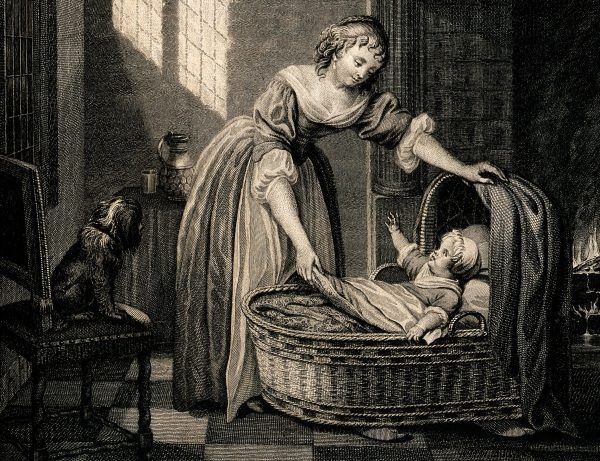The mighty of this world could be sure of one thing in their lives - the more people they stepped on, the more likely it was that their wine would be seasoned with a solid dose of poison. That's why the murderers tried to smuggle her in an umbrella, enema, and even ... a host.
Rumors spreading from court to court, from state to state over the centuries meant that whenever someone died in agony and pain, poisoning was suspected. And even when someone was overcome by malaria, tuberculosis, or puerperal fever, people preferred to repeat to themselves a more dramatic and mysterious version of events. And the more interesting it was, the more the murderers had to try!
Kings, aristocrats, and politicians often became paranoid, suspecting everyone of being poisonous. Fearing a painful agony, they became more and more attentive. The conspirators therefore had to look for methods clever enough to circumvent any precautionary measures . And they can not be denied creativity in this area - they simply outdoed each other in their original ideas.
Killer Mass
Monarchs, who sniffed poison at every turn, were careful at feasts, were careful while traveling, and even were afraid to touch objects. But there was a place that seemed safe in this regard. Of course, I am talking about the church, where a trusted confessor watched over the health and life of the ruler. As Eleanor Herman emphasizes in the book "Poison, or how to get rid of your enemies in a royal way", however, there was at least one exception to this rule:
When on May 26, 1604, King Henry IV of France opened his mouth to receive communion from the priest, his dog suddenly grabbed the royal garments with his teeth and pulled him away . Henry approached again to receive the host, but the dog pulled him away again.
The king decided that the animal was trying to warn him about something and ordered the priest to eat the messenger. At first the clergyman refused, but the king insisted. According to the account of this event written in Venice, "when the priest ate the host, he swelled and his body split into two".

King Henry IV of France avoided death as a result of poisoning, but there were still people who wanted to kill him. He died 6 years later by the hand of a dagger assassin.
The chronicler who immortalized this incident certainly had a tendency to exaggerate - there is no poison that can "split in two" . Perhaps it was a 17th-century way of describing the enormous suffering in the last hours of life. Suffice it to say that the aristocrats involved in the conspiracy were reportedly imprisoned in the Bastille.
This time Henry IV cheated fate, but almost exactly six years later he was not so lucky. A madman bomber ended the ruler's life with a long dagger. At least his death was practically instantaneous and he didn't die in agony after ingesting the poison…
Fragrant Pomander
If things were better in the past, it was definitely not in terms of fragrances. People in the Middle Ages did not like water, and feces (literally) ran down the streets. What more sensitive people could use the so-called pomander, the name of which came from the French pomme d'ambre meaning "amber apple".
It was a small, metal, spherical container, usually very decorative, which made it an element of its owner's jewelry. It could be worn around the neck, as a ring or on the wrist. How did he help with the stench? In a very simple way! Inside the pomander there were spices and aromatic flowers that you could smell when the wind blew over the River Thames or when your interlocutor thought a bath could kill him.
Often, herbs and aromatic ingredients were also hung from the waist, and then the fragrances were released while walking. The popularity of the pomanders was enormous (which is hardly surprising), so naturally they caught the attention of the conspirators. They assumed that it was enough to throw the poison into a fragrant ball to poison the victim with dangerous vapors. This situation is described by Eleanor Herman in his book:
A man (...) raised it to his nose and smelled a pomander that had been secretly poisoned, got dizzy, his face swelled and although he quickly got help by receiving sternutatories [agents that induce sneezing like pepper] and the like, he died shortly afterwards.
The last enema
For centuries, the enema seemed to many doctors a real panacea. They treated everything and everyone with it - even people suffering from severe diarrhea, which unfortunately only contributed to the deterioration of health. Especially if there was a dangerous poison in the pear!
This is what - it was not clever - was used by the murderers of the English poet and courtier Sir Thomas Overbury. The man died in torment in September 1613 in the Tower Fortress, where he was a prisoner. No one even thought that he might be a victim of a conspiracy . Death was believed to be of natural causes.

English poet Sir Thomas Overbury died in agony after being poisoned with ... an enema.
Ovebury, however, had a deadly enemy. It was his former friend Robert Carr, a trusted man in the court of James I Stuart. The gentlemen not only knew each other well - the poet worked for Carr as a secretary. However, he dared to write the poem "The Wife", in which he listed the features of an ideal wife. This was indirectly criticized by Frances Howard - the chosen one of Carr's heart, whom he considered an exceptionally immodest woman and not possessing so many virtues which upset even the king.
The too sincere poet was invited to go to a diplomatic mission in Moscow. However, Thomas Ovebury rejected this "generous" offer and it was then - as a punishment - he ended up in the Tower. The walls of the famous prison became silent witnesses of his death on September 14, 1613.
When after two years there were rumors that the poet's death was not entirely natural , the monarch ordered an investigation into the matter. It turned out that the deceased man was gradually poisoned by Frances and Robert. The drama ended with ... a lead enema that finally finished the prisoner. A pair of poisoners were sentenced to death but were eventually acquitted.
Accident or murder?
For centuries, many people feared poisoning through the skin. However, adult people had a good chance to sense the conspiracy, because the high concentration of the lethal substance immediately causes a warning symptom in the form of burning skin. Unfortunately, the child - especially tiny - could not signal what was happening. Such a case happened in England in 1857. In the book "Poison, or how to get rid of enemies in a royal way," Herman relates:
An Englishwoman thoroughly covered the body of her six-week-old daughter with powder that was supposed to be baby powder, but turned out to be arsenic . The girl had no way of saying that her skin was stinging her, and the poison absorbed into the bloodstream by the bubbles and intimate parts, took over the whole body, killing the baby.

Getting rid of an unwanted child by rubbing it with arsenic is a brutal but also creative way to murder (illustrative illustration).
The question is, was it a coincidence, or was it rather a calculating woman who had planned everything and then only pretended that her daughter had died by an unfortunate coincidence? Arsenic is often in the form of a white powder, and then it is easy to confuse it with flour or talcum powder.
In the nineteenth century in England, similar incidents were by no means isolated - this poison was in common use, it was found in many homes as the fastest means of fighting rats. It was therefore possible to inadvertently use a lethal preparation without having a trace of malicious intent. However, if the child's mother did it deliberately - you cannot deny her terrifying creativity.
Death ball
Poison was fashionable in the past centuries, but it has not been abandoned today. Yes, it is now easier to detect that a person has fallen victim to poisoners, but it is still a method that allows you to take a surprise victim. Especially if you have a good plan. Just like the Russians who decided to get rid of Georgie Markov.
Markov was a Bulgarian playwright and novelist who fully enjoyed the privileges of belonging to the Communist Party. In 1969, however, he decided to flee to England, and the KGB decided not to forget it. It cannot be ruled out that if his actions were to remain neutral, he might have felt safer. However, he got a job with Radio Free Europe and started unmasking the system from behind the Iron Curtain.
Meanwhile, Bulgaria failed to block the radio signal, and thus the inflow of information from the West. So there was only one way to minimize the damage - Markov had to be killed. When the latter, after receiving several veiled threats, did not resign from broadcasting, the State Security Committee began its operation in a sublime manner.
On September 7, 1978, the presenter returned from his job at the BBC. He was near Waterloo when a man ran into him. Markov felt a strong burning sensation in his leg, and the stranger apologized, picked up the umbrella he had dropped from the ground and walked away . From that moment on, the Bulgarian refugee felt worse and the doctors had no idea what was wrong with him. The unfortunate man suffered from hallucinations, fever and pain for three days until he finally died.
Only a vigilant pathologist discovered the mysterious cause of Markov's death - in his calf there was a tiny platinum ball with a diameter of only 1.5 mm. As it turned out, it contained a lethal dose of ricin, and it was fired from a mysterious man's umbrella equipped with a special mechanism.
